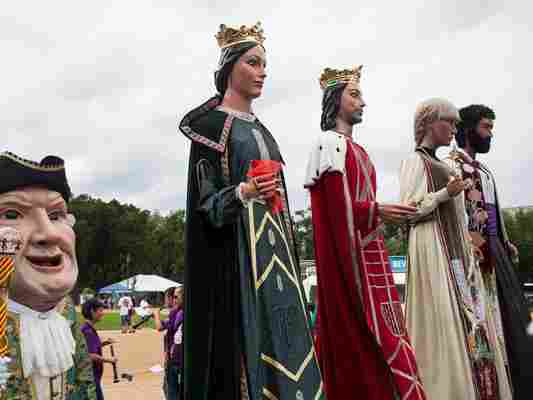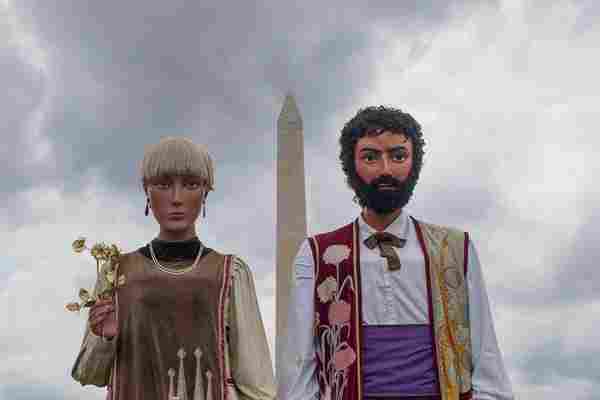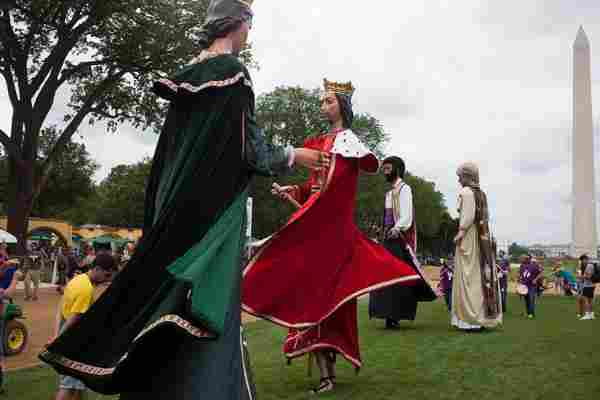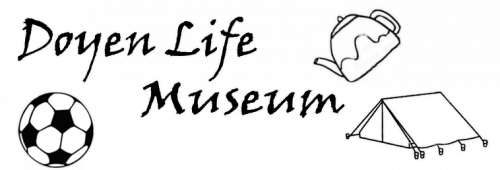
Rarely is the inflation of cultural icons as literal or striking as it is in the festivals of Catalonia, a region of northeastern Spain. There, in a tradition that dates back to Christian processions of the late 14th century, and that evolved across generations in response to industrial, political and social pressures, some citizens take to stilts and don majestic giant costumes while others dress more coarsely and wear caricatural “big heads.”
The interplay of giants ( gegants ) and big heads ( capgrossos ) is a focus of this year’s Smithsonian Folklife Festival on the National Mall in Washington, D.C., where native Catalonians are showing off a colorful assortment of the stately giant costumes and humorous papier-mâché heads.
Two of the giants on display, topped with gold crowns and clad in flowing red and deep green raiment, are region-specific. They were made by a group of artisans hailing from the small Catalonian municipality of Oliana, and one of the Olianan performers on site, Jesus Bach Marques, regards them with great pride.
“These two are called Andreu and Àngels,” he says, “like Andrew and Angels. They are one of the two couples of giants that we have in Oliana.” Àngels extends a bouquet of roses with a warm half-smile, while Andreu, her stern-faced partner, proffers a furled scroll suggestive of knowledge and power. “They honor the patron saints of our town,” says Marques.
The other two featured giants, while less overtly regal in their dress and demeanor, command reverence and attention in their own way. These represent Catalonia as a whole. A pale blonde giantess dressed in earth tones and holding a stem capped with flowers is a personification of “Culture,” while her black-haired bearded companion, holding a book under his arm, symbolizes “Work.”
“Since they represent the whole” of Catalonia, Marques says, “they were given names of values it is thought Catalonians have.”

A patron saint portrayed in big head form in a tricorne hat with arched brows and mouth agape provides a comical contrast to the two resplendent Olianan giants. The other big head on view, a bereted and bespectacled depiction of celebrated Catalonian artist Domingo Umbert Vilaseró , also wears an amusing look, part critical and part nonplussed. “Big heads are usually to make fun,” Marques says. They’re not straight-up insulting so much as endearingly irreverent, though. And the history of their relationship with giants—and the symbology underlying each—is quite complex.
Ohio State University folklorist Dorothy Noyes is delighted to delve into the history of these whimsical festival practices. She says the giants of Catalonia—as well as related festival staples such as beasts, devils and live mules—can be traced back to a religious march in the late 14th century. Catalonia had come under scrutiny from the Catholic hierarchy, and was eager to assert its merit both spiritually and culturally.
“There was a suspicion that the Catalans were heretics,” Noyes says. “So they really had to do a big Corpus Christi procession to show that they had their theology right and understood what the body of Christ is.” The festivities kicked off in Barcelona but soon spread to cities all over Catalonia. A spirit of one-upmanship took hold, and a wide assortment of labor guilds decided to try to make a statement by designing elaborate giant figures.
“One guild had a David and Goliath representation,” Noyes recalls. “They made a giant who was Goliath. And the giant was fun, people liked the giant. So eventually they made the giant a wife.” As the giants of Catalonia proved to be a giant hit—both as a means of signaling Christian devotion and hometown pride—they often were paired off in male-female couples.
In time, local bishops, displeased with the wild popularity of the devils and beasts also involved in the giant parades, attempted to put the kibosh on the whole thing, banning the costumes from churches and heartily discouraging their use elsewhere. Right up to the dawn of industrialization, however, communities across Catalonia continued to draw visitors from the countryside with the grace and wonder of their giants.
In the 18th century, giants were strongly associated with members of the noble class, who could gaze straight at them from their balconies while the common rabble massed in the streets below. This symbolism took a somewhat sinister turn with the rise of industry in the 19th century. As powerful businesspeople established acres of factory sprawl, they endeavored to frame their activities in a quaintly medieval way, cementing via the vocabulary of feudalism—and the imagery of giants and dwarfs—the subservient role of the worker in Catalonian society.

“This new bourgeoisie, who were making the textile factories and coal mines and so on, were creating a new ideology called ‘industrial feudalism,’” Noyes explains. “It was totally like company towns in America”—the grim corporate compounds in which laborers worked, lived, and bought employer-supplied groceries. “But in Catalonia, they had the Middle Ages as a symbolic resource for this. So they made company towns that looked like medieval walled cities, with a kind of castle in the middle, which was the house of the factory owner.”
Giants, and the big heads—also known as “dwarfs”—that emerged in this period to complement them, played a vital part in illustrating the new social hierarchy. The potentates of industry co-opted these symbols, Noyes says, to send a message: “This is our natural relationship—between giants and dwarfs, between an orderly, controlled upper class that stands as a kind of example and those below making efforts to improve themselves.”
Following that darker period, however, giants and big heads began to return to their roots of good cheer and regional pride. The raunchier aspects of festival fun, like the prank-playing devils and firecracker-munching mules, bubbled back to the fore, and big heads started satirizing folks from all social classes, rather than simply serving to keep commoners in their place. “There were both festival practitioners and political moments in Catalonia that were more democratic, more egalitarian,” Noyes says.
The giants, big heads and all the rest largely disappeared during the years of the mid-20th century when Gen. Francisco Franco ruled Spain; what giants were present were strictly royal symbols. “But then in the democratic period, with the revival of the festivals in the beginning of the 1990s,” Noyes says, “Catalonians started making giants that were not kings or queens, but that were celebrating local industry or famous local people.” A warmth and lightheartedness came back to the papier-mâché craft tradition—a warmth reflected in the performers on hand for the 2018 Folklife Festival in Washington, D.C.
Jesus Bach Marques thinks that the improbable longevity of the giant and big head traditions in Catalonia can be explained by their deep connection with the welcoming, free-spirited attitude of the Catalonian people themselves. “In Catalonia, we have many associations,” he says. “We like to associate, we like to make groups—to make dances, giant dances, cultural dances, everything.”
“Instead of going to the cinema, instead of going to another place,” Marques says, “you just meet your friends, and do these kinds of things. And then you travel around Catalonia, meeting new people with your friends, together with your friends, and it’s real nice. This is the essence of the culture, and what has made it last to today.”
The Folklife Festival will conclude after a final run from July 4 through July 8.
